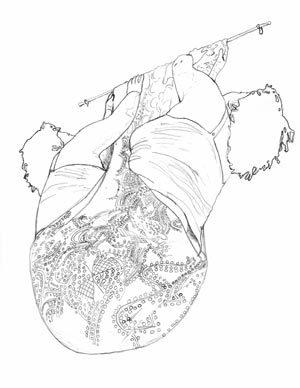
Aruba hosted between July and November 2012 the biennial meeting named Arte Contemporaneo di Caribe, first time in the region, sponsored by that Caribbean nation’s Ministry of Culture, UNOCA, as well as Piet Mondrian Foundation from Holland, among other organizations from both sides of the Atlantic.
The event, conceived to strengthen ties among creators from the heterogeneous group of these islands, was curated by Jose Manuel Noceda (Cuba) and a group of guest curators: Orlando Britto (Spain), Barbara Prezeau (Haiti) and Alejandro Mendoza (USA), who were in charge of organizing and holding workshops and exhibitions aimed at providing a multiple scene of expressions that presently gain momentum in local and international contexts.
The workshops were carried out by Gloria Bryce (Aruba), with title Arte Bibo and Rene Francisco Rodriguez (Cuba), who named his space Con el mismo sabor a boca. Mano a mano. Taking into account the participation of several groups of artists and enthusiasts, both creators shared their experiences and concerns and guided the respective audiences to the creation of works in multiple expressions.
Among the exhibitions, Giants in the City had great urban impact, with a series of 25 inflatable sculptures that were installed in public areas of Oranjestad, and some of the most outstanding pieces were those created by Jose Bedia (Cuba-USA), Edouard Duval Carrie (Haiti) and Alejandro Mendoza (USA), with symbolic allusions to mythology characters, fantastic and true animals, and abstract elements. With large dimensions and intense colors in harmonic contrast with trees, sea and the wild nature of this Dutch Caribbean territory, the sculptures remained fixed to the ground so as to favor contact with the public.
On the other hand, Haiti surprised with the photographic showcase of Josue Azor, whose black-and-white works, far from the themes related to the Caribbean nation, showed with unusual beauty some elements of their context from a different approach.
Happy Islands(25 artists from 14 countries under a humoristic title) turned out to be the most ambitious exhibition of all, by offering a panoramic outlook of trends, interests and tackled topics. It include: from Aruba,Ciro Abath, Nelson Gonzalez, Glenda Heyliger, Stan Kuiper, Osaira Muyale, Ryan Oduber and Ken Wolff; from Barbados, Annalee Davis and Sheena Rose; Sandra Ramos and Susana Pilar Delahante from Cuba; David Bade and Tirzo Martha from Curacao; from Guadalupe, Joëlle Ferly; from Guyana, Hew Locke; from Haiti, Maksaens Denis; Ebony G. Patterson from Jamaica; Jean-François Boclé from Martinique; from Puerto Rico, Charles Juhasz-Alvarado and Marxz Rosado; from Dominican Republic, David Perez Karmadavis and Jorge Pineda; from San Martin (France), David Gumbs; Kurt Nahar and Marcel Pinas from Suriname; and Nicole Awai from Trinidad & Tobago.
 Some solo shows were included in the program, such as Rene Francisco Rodriguez’ (Cuba); Party monster museum, by Venezuelan Luis Salazar; Territorios en fuga, by Alida Martinez (Aruba) and Conexiones insulares, by artist Yapci Ramos (Canary Islands).
Some solo shows were included in the program, such as Rene Francisco Rodriguez’ (Cuba); Party monster museum, by Venezuelan Luis Salazar; Territorios en fuga, by Alida Martinez (Aruba) and Conexiones insulares, by artist Yapci Ramos (Canary Islands).
This event took five months of 2012 and satisfied curatorial and communicative expectations with a public interested in getting in touch with recent productions of a wider context in terms of the nature of art and its role in emerging societies.
The Caribbean from the early days of the century is different in many senses, even if it preserves aspects that made it visible, over decades and centuries, to the eyes of visitors and the people from its regions. But there is no doubt that the progressive and permanent transformations of its varied symbolic production have positioned it within the field of action of new Latin American avant-garde movements, through the legitimate appropriation of worldwide contemporary heritage, or the search for unique expression components that avoid, somehow, the formation of stereotypes to satisfy curatorial or market expectations.
Even when formal results in terms of materials, color, technique, creation styles, have points of contact with local creations, which are linked to strong traditions with unquestionable ancient nuances, Caribbean proposals from the early 21st century show the changes assumed by their creators with more freedom, in an effort to express what they think and feel within their respective contexts, with rigor, professionalism, intelligence and emotion.
Related Publications

How Harumi Yamaguchi invented the modern woman in Japan
March 16, 2022












